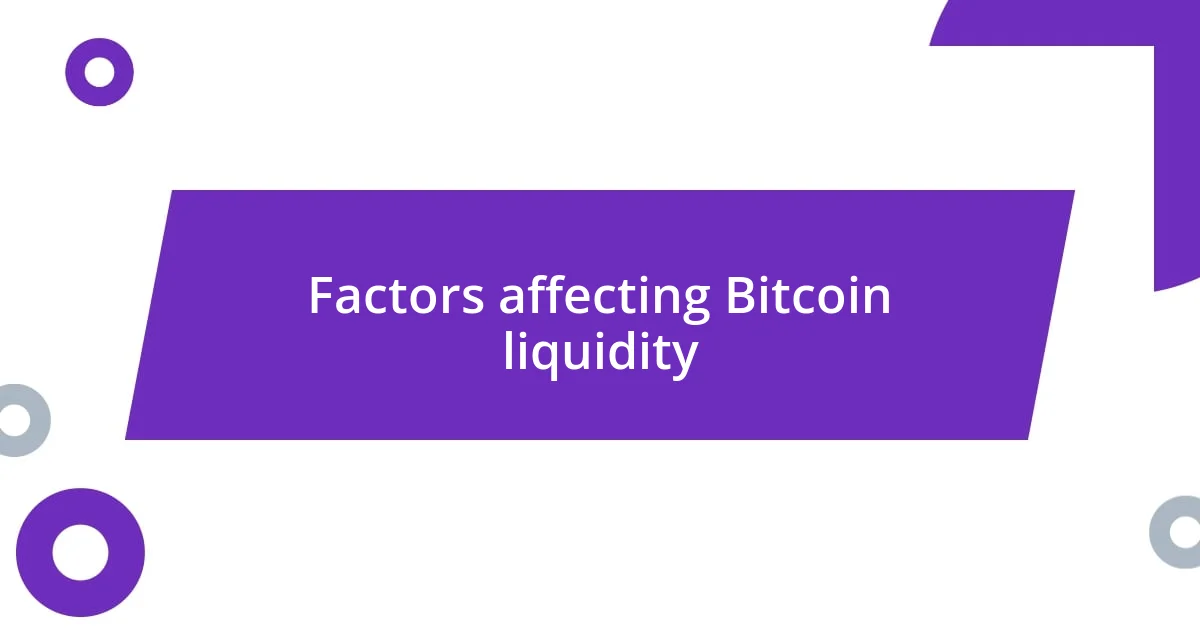Key takeaways:
- Bitcoin liquidity is crucial for ensuring ease of trading, market confidence, and price stability, significantly impacting trading experiences.
- External factors, such as market events, the number of active traders, and exchange technology, play a vital role in liquidity dynamics.
- The future of Bitcoin liquidity looks promising, driven by increased mainstream adoption, technological advancements, and clearer regulatory frameworks.

Understanding Bitcoin liquidity
Bitcoin liquidity refers to how easily Bitcoin can be bought or sold in the market without causing a significant impact on its price. I remember when I first started trading Bitcoin; I often felt anxious about whether I could execute trades quickly without losing value. It’s a bit like trying to sell a house—you want to do it quickly, but you also don’t want to drop the price too low in the process.
Understanding liquidity also means grasping how different exchanges and market conditions affect trading. Have you ever noticed how prices can fluctuate wildly in a matter of minutes? On days when trading volume is high, transactions happen seamlessly, creating a smoother experience. However, I’ve also witnessed days of low volume, where even a modest order could swing prices dramatically. It’s fascinating how the dynamics of supply and demand play out in real-time.
Ultimately, I believe that the balance of liquidity is key for any investor, whether you’re a seasoned pro or just dipping your toes into Bitcoin. When liquidity is high, there’s a sense of confidence—it’s easier to enter and exit positions. But when liquidity dwindles, it can feel like walking on a tightrope, making decisions more stressful. How do you approach those moments? For me, it’s all about knowing when to act and understanding the current market landscape.

Importance of liquidity in Bitcoin
Liquidity is a cornerstone of the Bitcoin market. I’ve found that when liquidity is high, it not only eases my trading experience but also instills a sense of security in my decisions. It’s much like walking into a bustling farmer’s market—you can easily find a buyer for those fresh tomatoes, and you can feel the energy in the air. On the flip side, during quieter market conditions, executing even a small trade can be nerve-wracking. I’ve been in situations where a simple sell order led to a striking price drop, leaving me in a state of frustration.
Here are some key points highlighting the importance of liquidity in Bitcoin:
- Ease of Transaction: High liquidity means I can execute trades quickly at stable prices without major slippage.
- Market Confidence: When liquidity is robust, it fosters a sense of trust among investors, encouraging more participation.
- Price Stability: In a liquid market, prices are less susceptible to wild swings; I remember feeling relieved when my trades went through smoothly despite larger market movements.
- Access to Information: A liquid market often reflects better information dissemination, allowing me to make more informed trading decisions.
- Reduced Risk: With higher liquidity, the risk of substantial losses is minimized; I feel more secure knowing that I can react to market changes.

Factors affecting Bitcoin liquidity
Liquidity in Bitcoin isn’t merely about the availability of assets; it’s also heavily influenced by market events and investor sentiment. I remember one time, during a major news announcement about regulatory changes, the market reacted dramatically. Prices didn’t just shift; they surged and plummeted in what felt like a heartbeat. Such events can create waves of volatility, affecting how easily I could execute trades. It’s a stark reminder of how external factors can significantly impact liquidity, and as a trader, I always keep a close eye on the news.
Another critical factor affecting Bitcoin liquidity is the number of active traders and exchanges. In my experience, when more participants are trading, the market feels vibrant and alive, almost like a busy café where you can easily find company and conversation. Conversely, during times of low activity, it’s as if the café has emptied, and my trades can feel like lone whispers in the vast emptiness. A well-populated exchange coupled with interest from diverse investors fosters a healthy liquidity pool, making it essential for anyone looking to trade effectively.
Finally, the technology supporting exchanges plays a significant role in liquidity. For instance, I once faced frustration when a particular platform experienced technical issues. I had a trade lined up, but the exchange froze, and I watched as the market shifted, completely catching me off guard. Efficient and reliable platforms minimize these risks, allowing for smooth transactions. I’ve learned that choosing the right exchange isn’t just about fees; it’s about ensuring there’s a fluid market where I can act when opportunities arise.
| Factor | Impact on Liquidity |
|---|---|
| Market Events | Can cause rapid fluctuations in prices, impacting buying/selling ease. |
| Number of Active Traders | A higher participant count leads to more stable prices and quicker execution. |
| Technology of Exchanges | Reliable platforms ensure smooth transactions, preventing missed opportunities. |

Analyzing Bitcoin liquidity trends
Analyzing Bitcoin liquidity trends reveals fascinating dynamics that can genuinely affect trading experiences. I’ve noticed that during bullish trends, liquidity seems to swell as excitement drives more participants into the market. It feels almost exhilarating—like being at a concert where everyone’s dancing to the same beat. But when the market shifts to bearish conditions, liquidity often tightens. Have you ever felt that sudden chill in your gut when trying to sell but discovering that the market has thinned out? It’s one of those moments that really puts the importance of liquidity front and center for me.
Moreover, I find that the market’s overall sentiment can shift liquidity drastically. For instance, I distinctly remember when a prominent figure tweeted about Bitcoin, and it was like a wave washing over the community. Trading volumes spiked, and it was fascinating to witness how quickly liquidity responded to sentiment rather than fundamentals. It leaves me wondering—how much can emotions shape our trading experiences? I believe that understanding these trends allows us to make more informed decisions and better anticipate market movements.
One specific trend I’ve observed is the correlation between liquidity and market maturation. As more institutions enter the fray, liquidity tends to improve, which I must say, gives me a sense of reassurance. During a recent investment, it struck me how institutions with deep pockets transformed our trading landscape. I felt a wave of assurance wash over me, knowing that I was trading in a more sophisticated environment. Isn’t it interesting how the market evolves? Keeping an eye on liquidity trends isn’t just about numbers; it’s about understanding the story behind the data and making that information work for our trading strategies.

Strategies for improving Bitcoin liquidity
Enhancing Bitcoin liquidity can be approached in several ways, and one strategy I find particularly effective is encouraging market participation through educational initiatives. When I first started trading, I often felt lost in a sea of complex jargon and market dynamics. If more traders understand the landscape, the market becomes more populated, creating a vibrant environment where buying and selling are smoother. Have you ever wondered how a little knowledge could drastically change your trading experience? I genuinely believe that better education can lead to a more engaged trading community, improving liquidity for everyone involved.
Another strategy I’ve found beneficial is promoting regulatory clarity. There’s something reassuring about knowing that the market has guidelines and protections in place. I recall a time when unclear regulations caused panic in the market, resulting in dramatic fluctuations in liquidity. It felt like being caught in a storm without a life vest. When regulations are transparent and consistent, traders can feel more secure, leading to increased activity and greater liquidity. Doesn’t it make sense to cultivate an environment where traders can thrive without fear?
Lastly, improving technological infrastructure is essential for boosting liquidity. I’ve seen firsthand how a lagging exchange can transform a seamless experience into a frustrating ordeal. Imagine trying to catch a bus—if it runs late or isn’t reliable, you miss your chance. Reliable and fast platforms attract more participants, contributing to the overall liquidity pool. Investing in technology that supports better execution and lower latency can make a huge difference. How much easier would your trading journey be if you could depend on your exchange to perform consistently? For me, this has become a key factor in choosing where to invest my time and money.

Future outlook for Bitcoin liquidity
Looking ahead, I see a promising horizon for Bitcoin liquidity, especially as mainstream adoption continues to gather momentum. Just the other day, I was reflecting on how different platforms are making it easier for everyday traders to access Bitcoin. This surge in accessibility not only invites more participants but also creates a sense of community. Don’t you think that sharing this experience with others can amplify excitement and confidence in the market?
I’m quite fascinated by the role of technological advancements in shaping future liquidity. For instance, I recently tried out a new trading platform that incorporated AI to optimize trades, and it felt like magic! The precision with which I could execute orders gave me a thrill—suddenly, I wasn’t just a passive participant but an active player in the liquidity game. It makes me wonder, how much competition and innovation can drive liquidity to new heights?
On another note, I can’t overlook the impact of regulation on future liquidity. It reminds me of a time when uncertainty over regulations led to wild price swings; I experienced a mix of anxiety and anticipation during that phase. The thought of a clearer regulatory framework brings a sense of stability, making me curious about how much smoother trading could feel in a more defined environment. Could this clarity lead to more substantial and healthier trading volumes? I honestly believe so, and I’m excited to see how this shapes the future landscape of Bitcoin.












